|

|
| View over Clayoquot Sound from Tofino, on the West Coast Vancouver Island |
Friday 30th Sept Vancouver
Last day in Canada, before returning to Australia !
I have spent the last four days discovering what makes Vancouver such a special city. I have stayed at a cooperative
community on West 2nd Avenue, Alternative Community Cooperative, invited by a friend Hida Levy, who I met in the Kootenays.
Its a 25 year old urban intentional community, connected to a rural cooperative at Fraser Common Farm near Aldergrove, outside
Vancouver. From there I explored by bike Stanley Park and other waterfront parks of the city.
An environmentalist friend of Hiddas, Rob Baxter, spend a day with me showing me Lynn Canyon Provincial Park and its
ecology centre, mountainous lookouts over the city, the UBC Museum of Anthropology, and the UBC Botanical Gardens. I always
find it entralling to see a city through the eyes of one of its inhabitents.
For my last two days in Canada I have stayed with Servas hosts, Sharon Book and Herman Bakker on west 37th Avenue.
Their environmental and social justice commitments are inspiring. Especially interesting has been meeting two of
the international uni students staying here as well, icnluding Meseret Taye, an Ethiopian born Masters student who has worked
for the WWF (World Wildlife Fund) in the USA.
I sold my Honda Civic yesterday to a nice guy in Abbotsford, who bought it for his 17 year old son to work on. Delivering
it in the pouring west coast rain was an adventure, but all worked out. On the return bus journey into Vancouver I sat next
to a Canadian Punjabi man, Balbir Singh, a warm and outgoing person. I discovered he was captain of the Indian Hockey team
that won gold at the London 1948, Helsinki 1952 and Melbourne 1956 Olympic games. He described how to build team spirit and
unity he had the whole team visit each others mosques, temples and churches. He now spends his time visiting his three
sons in British Columbia and part of the year in India.
I feel sad leaving Canada. The autumn colours are turning - and the woods and
gardens are so beautiful.
I feel enormous gratitude to all the people I have met across this huge country.
So many host families have made me feel at home and welcomed me into their lives for a window of sharing. So thank you to
all my new found Canadian friends !
24th September 2005 Salt Spring Island, British Columbia
Im on Salt Spring Island, which has about 10000 people on a beautiful gulf island with a mild climate and a fascinating
diversity of local busineses, many art studios, and organic farms. I am staying with a friend Michael Nickels, who first wwoofed
with me about 8 years ago and revisited me in about 2000. He now has a partner and and a young child, and today he showed
me over his patch of earth - organic garden, tree nursery, ecoforest that he harvests timber for furniture and his own building
projects, permaculture landscaping, wwoofer cabins and so on. He also is involved in helping start nurseries in Kenya, and
over past 15 years has helped local communities grow 3 million trees in their own nurseries.
I also met a friend of his (Dan Jason)who has a heritage seed business and has established a heritage seed savers network
across Canada - for example he grows and collects the seeds of almost 200 varieties of tomato alone -such a mind boggling
diversity that is so important to protect. I also met another friend of both my two sets of friends on Salt Spring who has
a collection of over 175 heritage varieties of Apples. I especially enjoyed tasting several varieties with rose coloured flesh.
Next weekend,he is organiser for a major apple festival on the island - which to me represents a powerful celebration
of an inspiring co-partnership of humankind and a bountiful nature.
Tomorrow I meet with one of the drivers of the Island's own currency, Eric Booth. There are local dollar notes
that are so beautiful and artistic that visitors happily swop Canadian currency for local dollars. There also appear
to be various other ways that people are encouraged to recycle their money back into the local economy. Every since my own
town's LETS (Local Exchange Trading System)went into dormancy two years ago, I have been on the look out for other local trading
systems that might work back in West Aussie.
It is a beautiful island- and with the fall appproaching the Maple trees are already turning a beautiful yellow and orange.
There are many art and craft studios - one map guide I have lists over 40, and the quality of the work is high. The island
illustrates a successful kind of culture and education based economy that many progressive communities are aspiring to- one
that is against the takeover by corporate chains, yet is open to progressive aspects of a globalised world (such as eco and
cultural based tourism).
18- 20th September Comox, BC
I travelled up the east coast of Vancouver Island to spend 2 days with Cathie and Davie Talbot. During this time
I visited the awesome public gardens- Milner woodland gardens in Qualicum Beach, Filberg in Comox, and Betty Coleman woodland
gardens near Courtenay.
"North Americans have a deeply ingrained habit of seeing nature and culture as irreconciably opposed; we automatically
assume that whenever one gains, the other must lose.....So how do we begin to find some middle ground between the two ? To
provide for our needs and desires without diminishing nature ? ... the place to look for some of answers to to these questions
amy not be in woods, but in the garden." (Michael Pollan: Second Nature: A gardener's education)
10-17th September Tofino, British Columbia
I've reached the end of the road. Here at Tofino, on the wild west coast of Vancouver Island, the Trans Canada
Highway terminates in the Pacific Ocean. I'm wwoofing at the Tofino Botanical Gardens (www.tofinobotanicalgardens.com) and loving it.
Tofino has to be one of the most fascinating towns I have visited in Canada. It's the heart of the Clayoquot Sound
UNESCO Biosphere Reserve and since the biggest forest protests in 1993 in Canadian history its been on the international environmental
map as a threatened refuge for one of the last great tracts of temperate coastal rainforest. (see the website of the
activist forest movement; http://www.focs.ca/index.asp ).
I have started to meet a range of local people to learn about the Clayoquot Biosphere Trust ( http://www.clayoquotbiosphere.org/ ) and the overall biosphere reserve program. So, I have had very informative discussions with such local folk as Stan
Boychuk, director of the Clayoquot Biosphere Trust, David Fraser, the Trust's Community Coordinator, and George Patterson,
one of the Trust's directors.
The trust has a divided board, which reflects a split between the towns of Ucluelet (with its forestry and fishing focus)
and the town of Tofino (with its strong ecotourism and conservation focus).
I spent a week wwoofing with George Patterson at the Tofino Botanical Gardens. George and his partner Josie, made me
feel very welcomed, and I greatly enjoyed learning about the local community through them.
Because I was a volunteer at the Gardens, I got to get a free boat ride with John Forde of the Whale Centre to the famous
hotsprings across Clayoquot sound. While I wont deny soaking in the springs beside the ocean wasnt a blissful experience,
the highlight of the day was coming in close proximity to grey and humpback whales, sealions and sea otters, all against a
backdrop of the spectacular forested mountains of the Sound.
Earlier in the week, I met with Glen Jamieson, a marine research scientist working in Nainamo, who helped establish the
Mt Arrowsmith UNESCO Biosphere Reserve. At the moment the biosphere association for Mt Arrowsmith is relatively dormant,
but it was valuable to get the run down of how it was established and past projects supported.
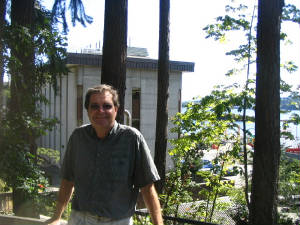
|
| Glen Jamieson, Research Scientist, a key person for the Mt Arrowsmith Biosphere Reserve |
7 - 9 Sept Nainamo District, Vancouver
Island
Nainamo is Vancouver Island's second biggest city. I spent four days with a Servas family (Yves Gregoire
and Maggie, Vincent, Nico Wouterloot). They live in an area of Nainamo close to the docks, a working class neighbourhood
with character and a sense of community. Spent a morning walking with Maggie and a friend of hers through the forests to a
mountain lookout from which the mainland coastland mountain range can be appreciated in all its glory.
I joined the family and their friends on a relaxed camping trip to one of the nearby Gulf Islands; Thetis. This
wooded island has about 350 residents, but large enough to have interesting nooks and crannies.
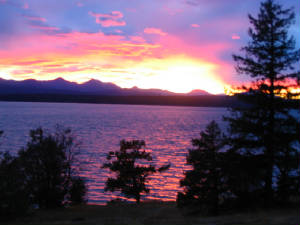
|
| Sunset from Thetis Island - Weekend Camping Trip from Nainamo |

|
| Yves, Maggie (Servas hosts) and friends camping on Thetis Island in the Gulf |
5th September Vancouver Island
Vancouver Island is a treat ! Even with the booming tourist trade, it is still possible to appreciate the many cultural
and environmental qualities of the island. I took the Ferry across and first stayed in Victoria with Servas host Holly
Vickers, who welcomed me into the home she and her husband, Barry, and niece, Cathy, had just the day before moved into.
While visiting the BC Royal Museum 's book shop I noticed a publication titled the 'The Community Green Map of Victorial
and Region'. Run by the internationally recognised group Common Ground, the map was the outcome of a fabulous community process
of documenting allthe special places of signficance. I am sure that this idea of 'community mapping' would be enthusiastically
accepted by many Australian neighbourhoods.
After sampling the marketstalls and daring buskers of Victoria's inner harbour, I have moved further up along the coast.
I have stayed with another hospitable Servas couple Conrad and Gillian Thomas, who live near Cobble Hill. I visited
the mural town of Chemainus and was entralled to see a town that reinvented itself through community arts. I got to meet Cim
MacDonald, an artist employed inthe town to maintain the murals, all of which portray historical insights into the town and
district. As one of the websites
(http://www.muraltown.com/) says 'from just five murals and lots of spirit in the summer of 1982,
Chemainus has struggled, grown and succeeded in literally putting itself on the map. In 1983, it won the prestigious New York
Downtown Revitalization Award for redevelopment of the town core. It has since gained world wide acclaim for the integrity
and superb artistry of its huge depictions of the town's history..'
Conrad and Gillian suggested I visit Providence Farm, which is a community run enterprise catering for disadvantaged
sectors of the community, including mentally ill, seniors and so on. A most impressive place, with beautiful public gardens,
a thriving horticulture enterprse, and innovative training facilities. For example they offer an accredited course in therapeutic
horticulture, which has attracted international students. See www. providence. bc.ca
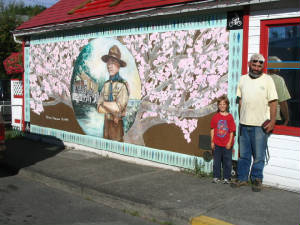
|
| Basil with Niko (of my Servas host family from Nainamo) in front of Chemainus historical mural |
4th September Near Vancouver BC
(In these web entries, I can mention but a tiny slice of my experiences and am tending to focus on those of
environmental interest. )
I spent the weekend with Peter and Sandra Beulens, of Abbotsford, in the Lower Fraser River Valley. Visited the Pacific
National Exhibition Fair in Vancouver, travelling with the light transit railway, and experiencing what makes Vancouver one
of the attractive large cities of North America.
Thanks to the Beulens, I got to meet Don Demill, filmaker and conservationist who has dedicated much of the last
two decades to helping save a unique wetland ecosystem of Burns Bog, close to the industrialised Lower Fraser River and Container
Port. He took me on a walk into the heart of the boglands, amongst the Sphagnum peat vegetation with their insectivorous sundews
and other remarkable plants. The provincial government has spent in the order of seventy million dollars buying back the Bog
from private developers - which just goes to show that small community groups (and individual consevationists) can make a
BIG difference.
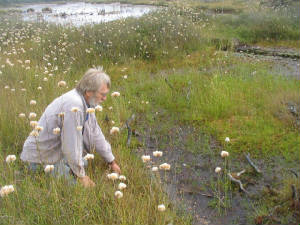
|
| Don Demill, Conservationist and Unsung hero of Burns Bog, Vancouver |
25-31 August Travels in the Okanagan Valley
For one day I experienced Osoyoos, the hottest, driest town in Canada on the US border with Washington - must be in the
rain shadow of local mountain ranges, as they have a little desert here complete with cacti,
rattlesnakes, sage
bush and ponderosa pines. It is a touch of New Mexico in Canada. I have just spent a few hours at an
Nkmip Desert Heritage
centre run by the Osoyoos Indian
Band of Indigenous Okanagan people.
This band runs many thriving
businesses in this area, besides the heritage centre they own
vineyard and wine cellars,
campground, construction business, schools
and are developing houses around the town - a real success story in
terms
of locally controlled and owned community enterprises.
Earlier in the week I spent 4 days with a remarkable man, David Orcutt. He lives on a loose knit ruralcommunity
which accepts wwoofers and other wayward travellers, in the Slocan Valley, about 60km from Nelson. He is 82 years old, originally
from Michigan, USA, but came up to Canada to avoid being drafted into the Korean War. He is a strong pacifict and social activist,
and I found it inspiring to hear stories from his life. He has developed a new language, which combines signing with conventional
languages as well as linking this to animation and drama.
Bbasically the language
he has created is described
as such ' Symbolvision is a multi-media,
multi sensory, augmentative system for personal and global
communication. Symbolvision
has four interconnected modes of
communication: symbol gestures, symbol writing and printing, symbol
animation and dance
drama.' I watched a video documentary about this and it brought to life - English (other languages as well)
accompanied
some of the demonstrations and helped to convey what was being communicated. It has particular potential applications for
people
with learning disabilities and needs, as well as in learning
other languages.
David outlined, in long discussions with me, how English and other
European languages have both tremendous advantages
but also
limitations. For example other languages (ie those of traditional
cultures on the West coast of Canada) place
much greater emphasis on verbs rather than nounds - this profoundly changes how processes and events are described.
For example David might ask me in the morning; how are you basiling today ?
Also David has invented gesture symbols for words like 'I' or 'you'
or 'we' which include an inbuilt understanding
that there is not a
seperation between the I individual self and the greater Self of the
wider cosmos. This becomes
illustrated in the embracing gesture
itself..
David has active plans to develop and promote this language further. He is also well read on the history of intentional
communities and it was enthralling to hear about some of the querky utopian communities that sprouted in North American in
the 19th and 20th centuries.
On the theme of pacifism, I spent a few hours at the Doukhubor museum in Castlegar chatting to Ron Mahonin, himself of
Doukhubor heritage. Strong pacifists, they immigrated from Russia at the turn of the last century, and were supported in this
endeavour by Leo Tolstoy, the welll known Russian writer. The Slocan valley thus provides a fascinating insight into
those groups or individuals who, because of their anti war conscience, have made the area home. The area was also a focus
for anti-Vietnam war resistors, who brought the values of the counter-culture along with them. The legacy of this is readily
apparent in the Kootenays today.

|
| David Orcutt, elder of the Slocan Valley |
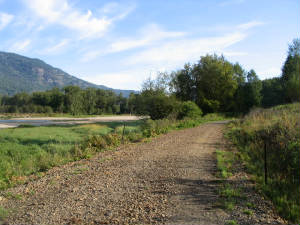
|
| Slocan Valley Converted Railway multi-use trail, in British Columbia |
19 - 25 August Kaslo, British Columbia
For 6 days I have wwoofed with the Peter and Joanne Vallen Allen, at the Lofsted community near the town of Kaslo. Again,
like Nelson, an alternative part of BC, with organic shops, lots of environmental group activities advertised on the town
boards, and attractive cafes.
Lofstedt Community biodynamic farm was established two decades ago and is linked to a 60 -80 family Community Supported
Agriculture scheme. I met the founding couple, Bridget and George Baumann, and enjoying learning about their interest in anthroposophy,
and their experiences of being part of a rewarding but challenging community. At the moment about 9 adults were volunteering
at the farm under various wwoofing and apprenticeship arrangements.
I had a very rewarding time staying with Peter and Joanne and their three daughters (Sorrel, Jasmine and Hazel). In addition
to work in the woodlot and orchard and cutting firewood for winter, I joined in outings to special local places.
This included a trip to a former fire look-out on a local mountain nearly 2000m high, a walk along Fletchers Falls, a
magnificent waterfall flowing into Kootenay Lake, and a horse riding tour of part of the 600ha crown land woodlot, that Peter
leases and earns his livelihood from.
Here in the Kootenay,s I have found it great to meet so many folk, both local and travelling through, intereted
in creating a more sustainable society.
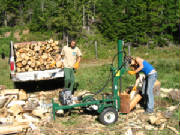
|
| Wwoofers Splitting Firewood On Lofsted Community Farm |
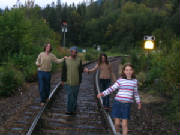
|
| Peter Van Allen (Wwoofing Host) with Family on Railwayline,Nelson |

|
| On a horse ride with Peter Van Allen through the selectively logged Lofstedt Woodlot |
16- 18th August Nelson, British Columbia
Nelson BC, is a centre for the counter culture in Canada. It is a dynamic town of about 10,000 people. The town is set
against a beautiful backdrop of the Selkirk Mountains and the Kootenay river valley. Having heard about the town for many
years, I was pleased to spend three days with Cattarina Henriksan, a servas host based in Nelson. It was good to lend a hand
to Cattarina with the house she is building a little way out of town.
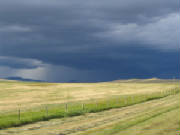
|
| Storm Clouds over the Prairies, Southern Alberta. Spectacular Sky displays.. |
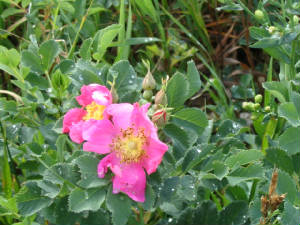
|
| Alberta Rose - Floral emblem of this provence |
11- 16th August Waterton Biosphere, Pincher Creek,
Alberta
For four days I stayed in the prairie district around Pincher Creek, close to the southern border of Alberta, and near
the Waterton Lakes National Park. This National Park forms the core of a long standing biosphere reserve, as well as
forming part of an International Peace park with an adjacent conservation reserve in Montana, USA. Also in the area are some
large wind farms taking advantage of the windy conditions on the prairies.
I stayed with the Frith family. Larry runs a herd of cattle on their accredited organic farm, while Jan is a nurse in
Pincher Creek. Their property is set in rolling grasslands with wonderful views of the Rocky Mountains to the west.
During my stay Larry and Jan introduced me to many of their friends and colleagues in the district including Bill Dolan,a
manager with the Waterton Lakes National Park, Kim Pearson with the Nature Conservancy of Canada, local ranchers and
others.
As a biosphere area, Waterton has achieved some noteworthy projects. The privately owned land bordering the National
Park was increasingly threatened with subdivision development, a move that would cut off important wildlife corridors and
habitat areas. Over a perod of about five years, the Nature Conservancy of Canada has invested over 45 million dollars to
buy up over 30,000 acres of land. In an innovative move, this land has been leased back to the original ranching
families, with the conservation needs of the land protected by easements and an environmental planning process. In addition,
a whole range of other wildlife conservation programs are underway to safeguard the rich biodiversity of this keystone area
in the Rockies.
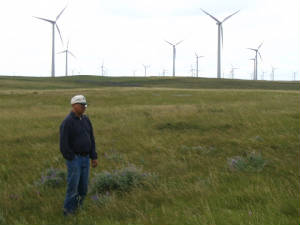
|
| Local farmer, Larry Frith on native prairies around Pairie Windfarm Southern Alberta |
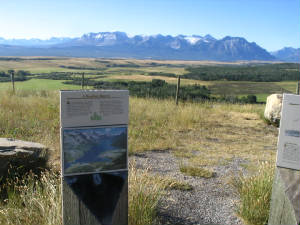
|
| Waterton Biosphere Reserve Signage, Southern Alberta - where the Priairies meet the Rockies |
9 - 15th August - The Rocky Mountains, Alberta
From Edmonton I headed east, stopping briefly to have a chat with
a servas couple Bill and Annette Sommerfeld, who live in the pulp mill town of Hinton. Bill is a retired logger and both have
much to tell of how Alberta has changed over the years.
Within a few kilometres, I was in the breathtaking Rocky Mountains, and it is one
of Canada's wonders how sheer and suddenly they emerge from the plains. I spent two days travelling down through Jasper
and Banff National Parks. Both parks have magnificent scenery which means that they are also tourist meccas, especially in
August. One highlight for me was seeing and walking on the Columbian icefields. Through crystal-like crevasses in the
ice, I could see and hear waterfalls of rushing water beneath the edge of the glacier. Even more interesting was the
array of brightly coloured stones left behind by the glacier as it retreats (a stark reminder of the reality of global warming).
I camped one night near Morraine Lake in Banff NP, and admired the remarkable colours of the landscape
- which are so much richer than that captured by photographs or film. In Banff, I was fortunate to interview Colin Funk and
Leslie Taylor, both with the Banff Centre. This is a long standing cultural and educational institution of international standing
that runs conferences, courses and educational programs - many of which relate to promoting awareness of mountain environments
and cultures. It was inspiring to see such a community driven centre in a small town - illustrating for me what towns
in the south west of Western Australia might achieve if they can harness the collective talents and resources of their citizens.

|
| I camped a night beside this lake in Jasper National Park, Alberta |
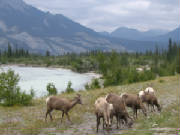
|
| Wildlife in Jasper National Park, Alberta |
Monday 8th August Edmonton, Alberta
After an enjoyable stay with the Hawrysh family at Redberry Lake, I kept moving across the prairies towards Alberta.
I stopped at the city of North Battlefield, still in Saskatchewan, at the Allen Sapp art gallery. It contains a fine
collection of a living Cree artist and provided an insight into a life of a contemporary First Nation person. Also on display
in the city was a collection of coloured photos from the 1930s and 1940s taken by Everett Baker, who did much to promote
and spread the cooperative sector in rural Saskatchewan. Before leaving town visited a well resourced environmental education
centre set on some restored wetlands close to the North Saskatchewan River, and typical of a number of such centres spread
through the priairies.
At the Alberta border I was stopped by the Royal Canadian police who checked out my paperwork and blood alcohol levels
before sending me on my way. Needleless to say the police in Australia maintain much higher presence on the roads than I have
noted here. I prefer the Canadian model.
Magnificent storm clouds lit up the sky as I set camp beside a forested lake a hour or two outside of Edmonton. It rained
a fair bit that night so it was good to have a waterproof tent to shelter in.
Next stop was Elk Island National Park, with close up views of a fine Bison heard. Apparently August is the beginning
of the rutting season, and certainly the male bulls were putting on a fine display of snorting and kicking up dirt. Absolutely
magnificent animals, and I am glad that my childhood hero of Buffalo Bill didnt wipe them all out.
Edmonton I find to be very similar to Perth, Western Australia. Both are cities booming from resource booms in their
responsive states. I arrived at the tail end of large folk music and Carribean culture festivals. Certainly Canadians make
the most of their short summers to have a lot of celebrations.
I stayed with a Servas host who lives on a large housing coop, set next to riverside parkland close to the down
town area. It was great to see a successful non equity coop (59 homes) that has been around for over 20 years, and part
of a solid housing coop movement in the city. Yet again I was provided with evidence that the cooperative sector in Prairies
is much more extensive and successful than in southern Australia.
I decided to experience urban civilisation after roughing it in rural Canada, so saw an art house movie
' Me and You and Everyone We Know'. It has won quite a few film festival awards, but personally I found it quite disturbing
and disturbed. I always treasure those times I watch films which show an affirmative portrait of the human condition.
Alberta is certainly the most american of the Canadian provinces, and consequently not as appealing to me.
It appears that oil money talks big here, and the local politicians have a tendency to criticize every concession
made by Ottawa to Quebec and francophone Canada. The current controversy is the recent appointment of a Haiti born Quebecoi
woman to the position of Governor General. Alberta talk back radio is having a field day, or so it appears as I
listen to the radio driving towards the Rocky Mountains, which loom every closer...
During my visit to Edmonton I caught up with Theresa Chilkowich who works for Environment Canada and who had been in
Denmark earlier in the year to do a Johanna Macy workshop. Theresa gave some good hints on places to see and camp in the Rockies
as well as interesting environmental contacts in southern Alberta.

|
| Edmonton City Scene - A prosperous city (not unlike Perth) |
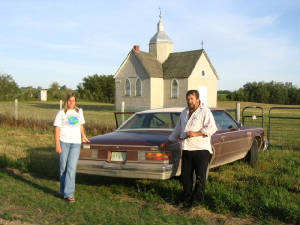
|
| Larry Hawrysh with his daughter Cia, in front of a Ukranian church near there farm at Redberry Lake |
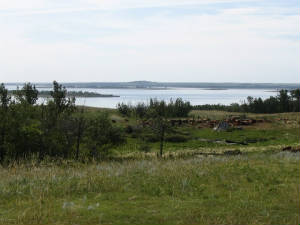
|
| Redberry Lake Provincial Park, Saskatchewan, centre of the biosphere reserve |
Friday 5th August - Hafford, Saskatchewan
I am now into my second day at Redberry Lake, north east of the pretty
prairie city of Saskatoon, in central Saskatchewan. It forms the core of a biosphere reserve. I am staying with
another very hospitable farming clan, the Hawrysh family - who are organic cereal growers, and involved in
all things to do with local community development and environmental issues. The biosphere group here is in the process
of restoring and refurbishing a research and education centre beside the lake, which is famous for its birdlife,
including migratory species.
Today I saw a ruby throated hummingbird, which also departs each year to Mexico
where it likes to hang out over winter, as well as American Pelicans, which breed in their hundreds on an island in the Lake.
I have been entralled to find out about some of the lake systems here in the prairies which host literally millions of
birds each year on their migratory routes from northern Canada to southern lands.
My hosts are Ukrainian in heritage and across the prairies I have been struck
by the distinctive Ukrainian churches, both orthodox and catholic, as well as memorials to the trials and tribulations they
endured when they first arrived in the early 1900s.
It appears that is tough going promoting new initiatives in this rural area, which has
been affected by the harsh climate prevailing over theagricultural sector in these parts. There is considerable
animosity towards environmentalism, and even iniatives to develop better recycling programs have not yet met with success.
However I am inspired by the guts and persistance of those who are continuing to show leadership in this area. What is interesting,
is that as regards social policy, Saskatchewan is quite progressive, with a strong well established coop sector, and
well known across Canada as a trail blazer with social reforms.

|
| Sign promoting biosphere reserve at Hafford, close to Redberry Lake, Saskatchewan |
Riding Mountain Biosphere Area - 1 - 4th August
After Winnipeg, I headed north westwards across the flat agricultural
landscape
of central Manitoba. Its the sky in the Prairie world that
is special - a vast canvas that is ever changing. If Ontario's
archetypal
element was water, then Manitoba's is surely air.
Close to Riding Mountain is the Manitoba escarpment, a subtle but
important
wooded landform stretching hundreds of kilometres. At a streamside picnic spot on the escarpment I had one of those surrendipitous
events, a converation with a local nurse/farmer having a day off. As a whole bunch of ATV (all terrain vehicles)
descended on the picnic side and proceeded to rip up the waterway, it was good to hear that such laconic behaviour wasnt appreciated
by all locals.
Then came three days staying with John and Sharon Whittaker, cattle farmers in
the biosphere area close to the Riding Mountain national park. They are the sort of committed farmers who make community
happen, and both are active on a whole range of environmental and agricultural committees. John is chair of the
local biosphere network and was able to provide we with a broad overview of the achivements and challenges facing the local
landcare movement. Their hospitality and friendliness is legendary.
During my stay I met with folk involved in the biosphere and the National
Park and did a guided walk in the National Park with a seasonal parks person, and went looking for re-introduced bison,
but was not able to achieve that childhood goal.
Its a culturally and ecologically rich part of Manitoba, with over 60 mammals occuring
in the park (including half a dozen re introduced ones including beavers).
I did manage to team up an amazing visit to a local Hutterite Brethern community
(the Hutterite Cool Spring colony near Clanwilliams). The community's Minister showed me around - closer to utopian collective
settlement than any I had ever visited including the Kibbutzim. About 40 adults and 25 children live in the community which
includes a state of the art pig farm, silos, a 5000acre cropping enterprise, woodworking and steel factories and a community
centre, church and school complex. I was informed that since 1988 when it started it represents a 20 million dollar investment.
I found the contrast stark between the strict early protestant values of the community
and the sophisticated technology employed in the business arm of the community. Clearly successful in its own terms, the lack
of colour, art, untidiness and trees made me value the informality and spontaneity of the south coast Australian communities
I am part of. I am stil astonished to learn that there are many such Hutterite communities in Western Canada.
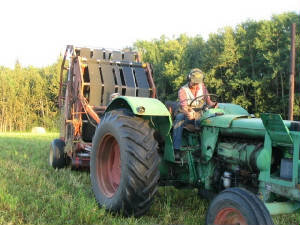
|
| John Whittaker, Farm from near Riding Mountain, making hay bales |
28th to 1st August Winnipeg, Manitoba
I've just spent five days in Winnipeg, the vibrant capital
of Manitoba. Servas hosts Marlene and Gysbert Crielaard, and Chris McCubbins and Susan Jacobsen, went out of their way to
introduce me to their city. It seems I have arrived in the middle of a cultural frenzy: a major theatrical fringe festival,
a host of ethnic festivals, a Folkarama dance and food festival, and more.
A highlight of my visit was walking through a remnant patch
of praire at the Living praire museum (see www.livingprairie.ca for a fabulous website about this rich ecosystem)
I also met up with the Kettner family (Bruce and Fern, Madeleine and Jacob) and
visited them at their summer cottage on WillowIsland on Lake Winnipeg. From them I sampled a bit of the dynamic cultural life
of Jewish Winnipeg, including watching Madeleine and Jacob perform in Israeli folk dancing at the multicultual folkarama festival.
I sampled some of what makes Winnipeg special by visits to the Sam Mol Sculpture park in Assinibone
Park, beside the Red River, St Norbets Arts Centre (which used to be a Trappist Monastery and now focusses on environmental
and community art initiatives (www.snac.mb.ca).
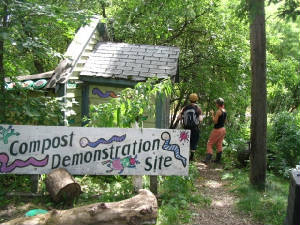
|
| Touring the Compost Demo facility at Centre Norbert, Winnipeg |
23rd - 27th July Northern Sun Farm Coop Community, near Steinback, Manitoba
After travelling vast distances across Western Ontario, I decided to stay put for a while and spent four delightful days
wwoofing with Gerhard and Dawn on Northern Sun Farm Coop. The community is beautifully located in aspen,oak and ash woodland
in a mainly agricultural district 8okm or so south of Winnipeg.
The Coop is shared by six or so members, is off the grid and employe solar and other appropriate technologies.
It is a fine example of a friendly community working towards small scale sustainability with productive vegetable
and berry gardens, animals, etc.
One afternoon I went fishing with Dawn and Gerhars' boys Noble and Sam, and caught my first fish in many years !
What a pleasure to spend the long summer days, helping out with building or gardening work, swimming, reading, drawing, jamming
and lots of talking..
I found it fascinating finding out much more about the Mennonites, who have a stronghold in the Steinback district, their
history, as well as the cooperative ventures they have established. In addition there are French, Ukrainian and other
immigrant communities in the district which gives Manitoba a strongly multicultural flavour.
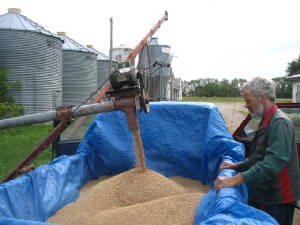
|
| Gehard of Nth Sun Farm Coop with load of organic wheat from a Mennonite Farm |
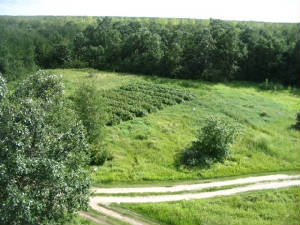
|
| View from Wind Turbine Platform of Rasberry Patch and Forest at Nth Sun Farm Coop |
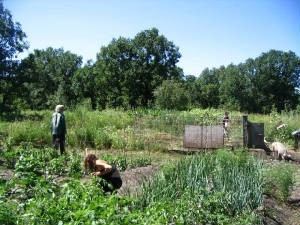
|
| Gehard and Dawn in Organic Garden at Nth Sun Farm Coop |

|
| Noble and Sam with caught Jack Fish, Manitoba River |
Wednesday 20th July 2005 Sault Ste Marie to Thunder Bay
After leaving St Josephs Island I met up with three long time residents of Sault Ste Marie, the closest city to the island.
Aileen Hadden and Joyce Mertes are my friend Margaret Whittle's cousins, and Vivian Martin went to nursing college with
Margaret. It was delightful to swop stories.
From there I proceeded west along the northern shores of the vast Lake Superior, stopping off at some of the exquisite
conservation parks and scenic spots along the two day drive to Thunder Bay. I made a point of visiting the local museum at
White River, where the original bear that inspired Winnie the Pooh came from. (A Canadian army officer brought a black bear
cub in the First World War to London where it was left in the Zoo and inspired the famous story. Winnie by the way stands
for Winnipeg)
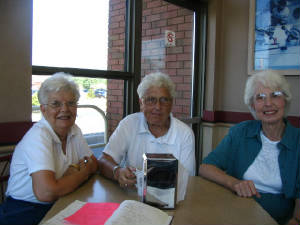
|
| Meeting with Vivian,Aileen, and Joyce in Sault Ste Marie |
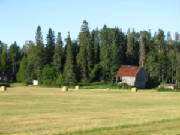
|
| Old Barn on Elsie Mole's Farm, St Jospephs Island, Ontario (close to where Margaret Whittle grew up) |
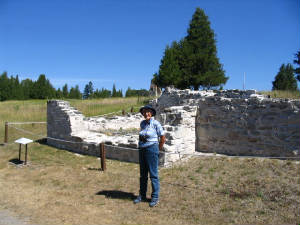
|
| Elsie Mole at historic fort on St Josephs Island destroyed in 1814 by US attack on Canada |
Wednesday 20th July 2004 St Josephs Isand
Today I left St Joseph's Island, near
Sault Ste Marie, after two days staying with Elsie Mole on her small farm on this special island. Elsie is my friend Margaret
Whittle's first cousin, and she kindly showed me places on the island of significance to Margaret's family.
The island is sandwiched between mainland Canada and the
United States, and on the Saint Marie waterway between Lake Superior and Lake Huron. It has a rustic rural landscape with
small family farms and many grand old barns and wooden rale fences set against woodlots of native forest. Elsie introduced
me to old friends and family members, all of whom fondly related tales of Margaret and Margaret's mother Winnifred, whose
war time letters have been published in a delightful illustrated book "Dear Home Folks".
The island captures something of tradtional Canadian
rural life, governed by the dramatic seasons, and seemingly far away from the troubles of city life.

|
| Sunset over Gore Bay, Manitoulin Island |
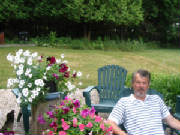
|
| Chuc Willson, a Manitoulin local, who tried to get support for biosphere listing on the island |
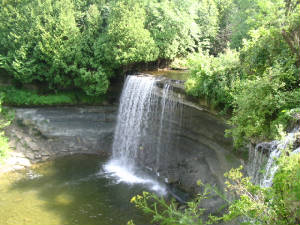
|
| Bridal Falls on beautiful Manitoulin Island |
Tuesday 19th July - Manitoulin Island
I have just spent day on Manitoulin Island in Georgian Bay, where I
met with a local person active in the
Farmer Markets movementn, Chuc Willson, and heard about efforts
of a local group to get a new UNESCO biosphere reserve on
the island but hit opposition from conservative elements
in the
community. The proposal is now dormant, but their expereinces reinforced to me the
need to slowly build community
understanding for a new or proposed biosphere area, to involve key community leaders in helping
promote the
idea from the beginning, and to not 'burn out' at a
personal level if things don't go well!
So far on my Canadian trip I have visited Frontenac Arch
Biosphere, Georgian
Bay Biosphere, and Niagaran Escarpment Biosphere
areas all in Ontario, and met with some enthusiastic and bright
representatives
of community organisations there. Lots of inspiring
projects but some challenges as well in promoting sustainability
in such consumer focussed economy.
Through these visits and through wwoofing (world wide opportunities on organic
farms)
on several properties in Quebec and Ontario I am starting to get a
handle on where Canada is more innovative
on environmental matters than Australia.
While on Manitoulin Island I also visited the Ojibwe Cultural Centre, and besides admiring the
ecologically sensitive paintings and stories on display, also came away with a better undestanding of the challenges facing
First National peoples in Canada.
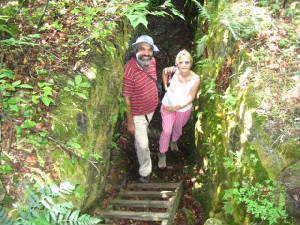
|
| Myself and Danuta on the Bruce Trail, near Owen Sound |
Sunday 17th July Owen Sound
What a pleasure to meet an old friend from Australia, Danuta, now living in Owen
Sound with her husband Michael, and teenage children Angus and Afra, who I haven't seen since they much smaller.
Owen Sound is an attractive town set at the base of the Bruce Peninsula. Danuta and Michael took me
for a drive to their new rural home, currently in the final stages of completion, and for walks along the stunning Bruce Trail,
an 800km trail that follows the Niagaran Escarpment, with occassional spectacular views over the limestone, fossil containing
cliffs of the escarpment down into Georgian Bay.
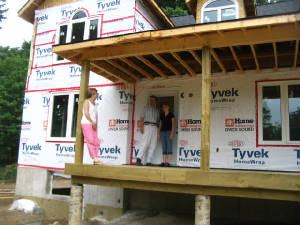
Saturday 16th July Parry Sound, Georgian Bay
I've spent two days exploring part of the Georgian Bay area. It comprises beautiful coasline with thousands of islands
and this part of the Bay was recently given UNESCO biosphere status. Rebecca Pollock and Greg Mason, both key people
in this biosphere group, hosted me for my stay here. They organised a dinner at which I met several of their friends and colleagues
involved in the biosphere. One of these was Kenton Orherbau, an Interpretative officer at Killbear Provincial Park. The next
morning I visited the park and watched Kenton in action introducing visitors to two remarkable snake species found in the
area - a rattlesnake and the Eastern Rat Snake, from the constrictor family. He had live examples of both species on hand
to add to the interest.
In the afternoon I was invited canoeing on a local lake and river system with Faith Mansfield, another friend of Greg
and Rebecca's. Another highlight of my visit to Parry Sound, was a visit to a local Wasauksing First Nation community on Parry
Island. There I met two First Nation men, and hear about some of the issues facing their community, including the lack of
employment. At the end of our converstation they provided me with a cap sporting a native logo which they explained illustrating
the coming together of the red,yellow, black and white peoples - clearly a gesture of goodwill and co-operative
intention.
This morning I saw my first racoon on the edge of town park. The list of first sitings thus grows: chipmunks, squirrels,
black bear, white tailed deer, beaver, otter and more. I am now on the look out for moose - hopefully not in the middle
of the road !
I visited an "Art in the Park" market in Parry Sound before heading south out of town. There I spoke to an landscape
artist, Barry Bowerman, who is also an engineer at a large nickel and copper smelter at Subury north of here. He has
strong conservation interests and I found it informative to hear about the environmental reforms made in his industry.

|
| Rebecca Pollock of Parry Sound, with their biosphere display |
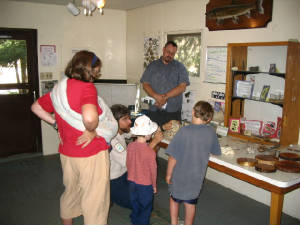
|
| Kenton Ortherban, A Killbear Provincial Park Interpretative Officer talking to visitor |
Thursday 14th July Bracebridge,Ontario
Wow, there is a quite a heat wave on - record temperatures in Toronto. Luckily, plenty of lakes to cool off in.
The highlight today was visiting the internationally recognised Dorset Environmental Science Centre. My Servas host is a freshwater
biologist, and is an associate professor at a local university. They focus on researching the ecology Ontario's lakes, and
have done ground breaking work monitoring the effects of acid rain, climate change, invasive species and so on. I also heard
about a community based Ontario Lakes Partnership project, which has been running for over 20 years, has nearly a thousand
volunteers monitoring phosphates and water clarity in hundreds of Ontario's lakes.
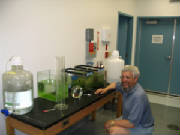
|
| Prof Norm Yan, Freshwater Ecologist, in his Laboratory near Dorset |
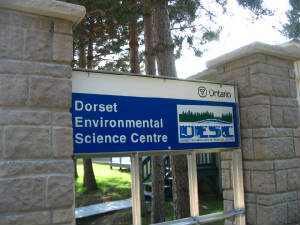
|
| Dorset Environmental Science Research Centre - Famous for Lake Research |
Wednesday 13th July - Bracebridge, Ontario
I am now staying with Servas hosts, Sandy Yudin and Norm Yan in Bracebridge. Bracebridge is an attractive town with many
waterfalls close by. Sany is a key organiser in Servas Canada, and runs a B and B and Norm is a freshwater biologist with
years of involvement in the environmental field. So I have learnt a lot, being here. In Ontario is there is a Lakes
Partnership project which sees the provincial government working with a network of a thousand volunteers for monitoring lakes.
It seems to have a magic ingredient which keeps it going, unlike some of the community monitoring programs back in Australia.
Tuesday 12th July - Bancroft, Ontario
I am now travelling in Eastern Ontario after 4 special weeks in
Quebec. The two weeks I spent on two Camphill affiliated
communities
set up to provide rural, educational setting for people with
disabilities were very inspiring.
One recent Servas/wwoofing host in Quebec, Ilania, was an Israeli born
artist who lives in the Laurentians north of
Montreal. She is 68
years old, lives with her 80 year old partner, Ken, in her bungalow beside
one of the many
lakes, is fluent in several languages, and very
active in the local art scene. Being Jewish we had lots to talk
about.She
actually helped me set this web site
Ilania also did a web page on me - it is quite fun so see
I then stayed with two writers, Wayne Grady and Merilyn Simonds, who are wwoofing hosts near the
town
of Athens, north of Lake Ontario. We have lots to talk about,
and it is interesting being with two well published authors,
including
on environmental themes. I enjoyed helping them cut
their firewood requirements for the Winter (and of course, being
Canada,
they need lots of wood !).
I met with representatives of Frontenac Biosphere, whose
biosphere area covers the Thousand Islands section
of the St Lawrence River, bordering the USA, a scenic, well wooded, high biodiversity area that appears to have a variety
of interesting community development initiatives.
The actual biosphere network group is
closely linked to community conservation organisations, as well as
small
business, agency and local government.
It has three staff, and the organisation is quite similar to Green
Skills (although considerably smaller) in that
it takes on labour
market placements, seeks fee for service environmental contracts, and
is accountable to a board of
management that includes a crossection
of the community. It is quite new, being gazetted in 2002 (after 6
years of work)
and appears to be finding its feet.
I have had a chance to visit a couple of the national parks and
provincial parks that form the core areas of the biosphere,
which are
fabulous, and where I am wwoofing is in the upper reaches of this
biosphere reserve.
From the 9th to the 11th I have been wwoofing at an intentional
community (about 5 houses and 9 or so adults)established
in 1972
called Lothlorien Farm (named from Lord of the Rings) near Ompah,
about 2 hours west of Ottawa.
I met about 7 members of this friendly community, agreat bunch of progressive folk, and a real insight into counter
culture
movement in Canada.
27th June 2005 Val Morin, Quebec
I am wwoofing (world wide opportunities on organic farms) here a
Maison Emmanual (a Camphill associated
community for people of
special needs - they have a website www.maisonemmanuel.org if you are
interested - it is a truely
remarkable place for the quality of
caring and education they aim to provide in this rural setting)
Today I worked within the maison I am staying, helping the ``house
guardian and coworkers with the mountains
of laundry that needed
drying and folding, spending time with the young folk, going for a
walk in the early morning
and so on. I am moved by the skills and
experience some of these coworkers bring to their job - how well
they have got
to know the villagers under their care, how some have
learn sign language to communicate better, and how some have both
a
sense of setting firm boundaries but also a sense of playfulness and
fun... all of this in a community in crisis,
with some serious intra
conflicts.
This community is only loosely affiliated with Steiner`s ideas, which
means
there is not much rigidity about what should or should not
happen.
After yesterday`s time in nature, I feel positive
about life - but
looking forward to returning to a normal wwoofing routine
tomorrow,probably putting coats of varnish
on outdoor deckings.
 |
 |
Jim Franchetto, Program Coordinator,
Frontenac Arch Biosphere, Ontario, Canada in front of the Biosphere Network office
|
Visiting Biosphere Reserves
One of my aims for visiting Canada is to visit five of the 13 or so Canadian
UNESCO Biosphere Reserves. In early July I visited my first one: Frontenac Arch Biosphere, in Ontario, beside the St Lawrence
River and its Thousand Islands National Park
|
|
 |
 |
|
